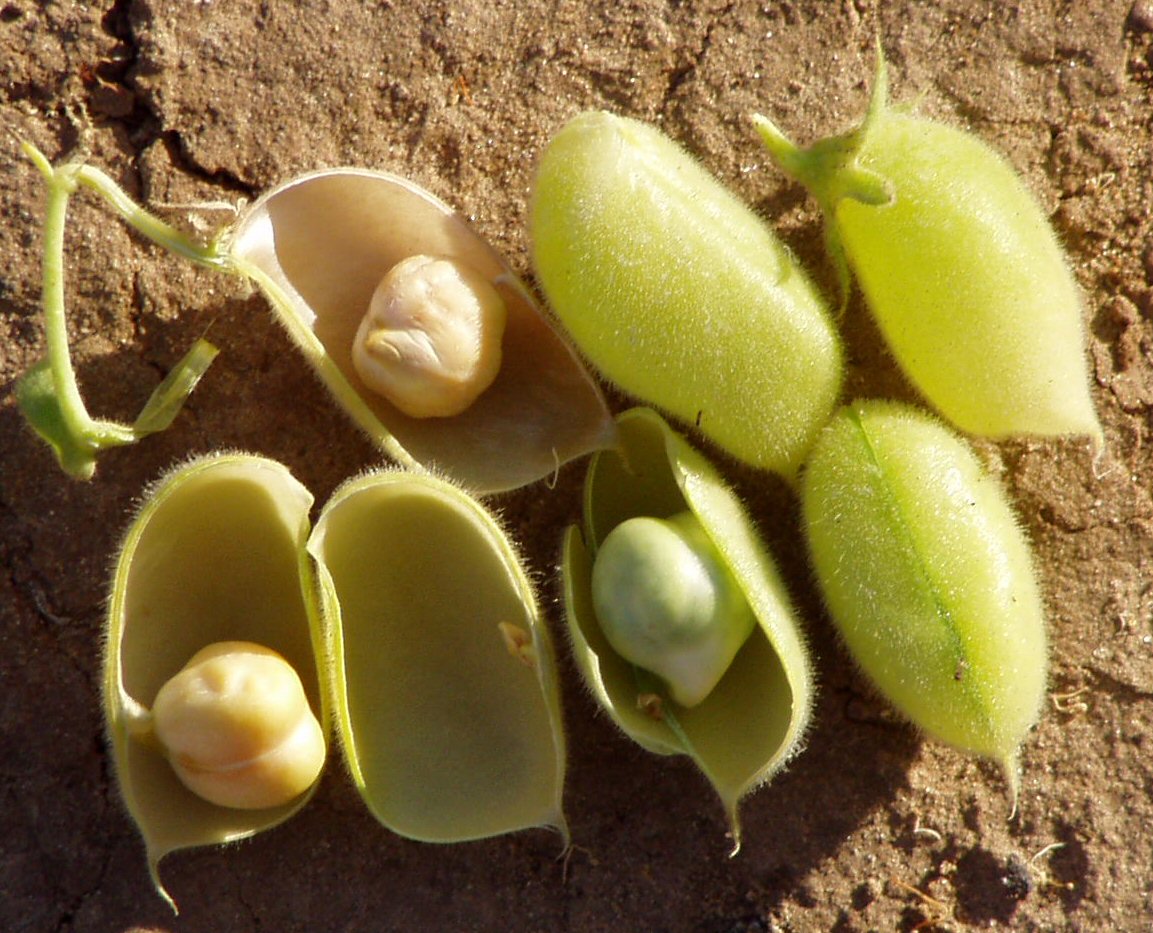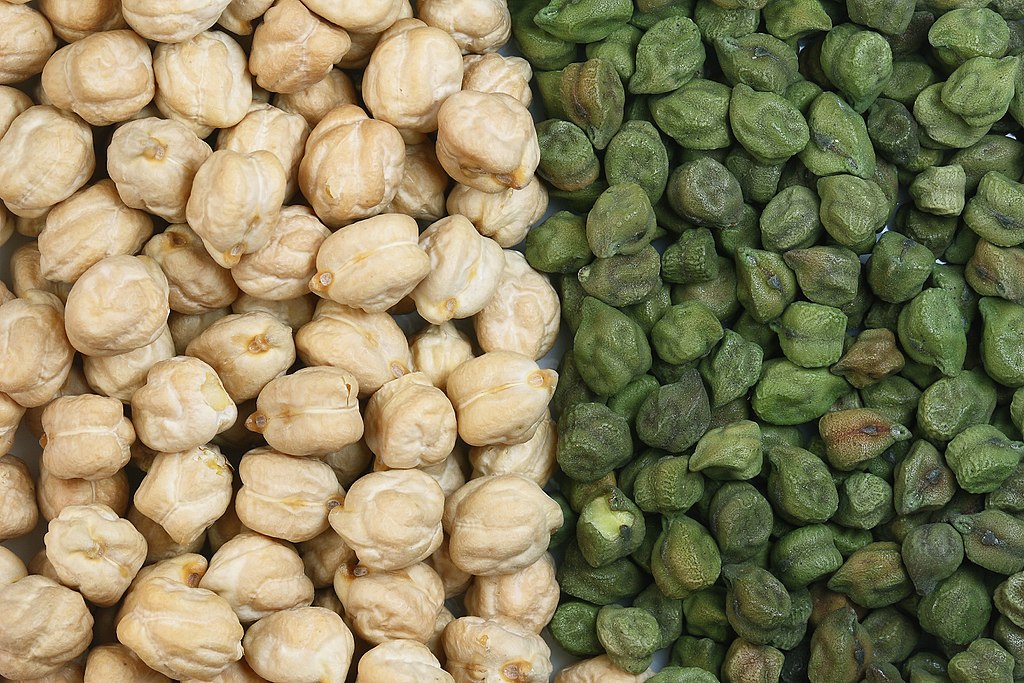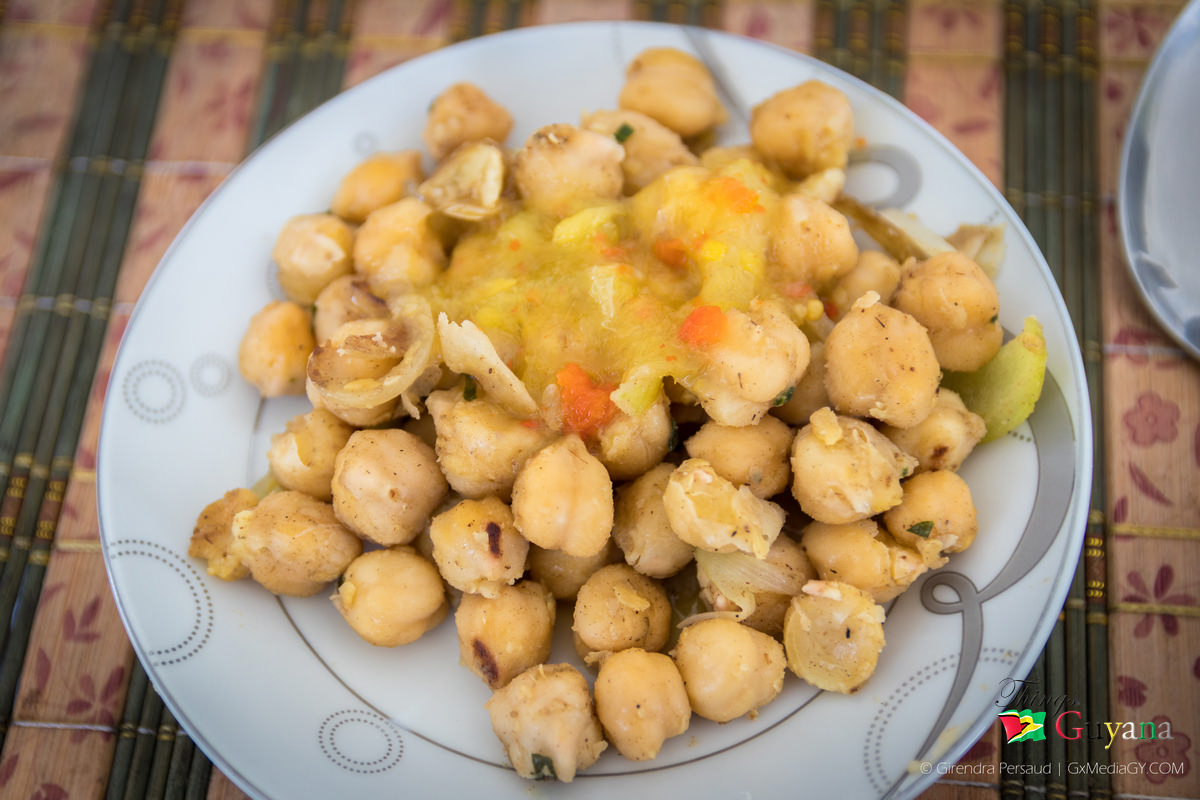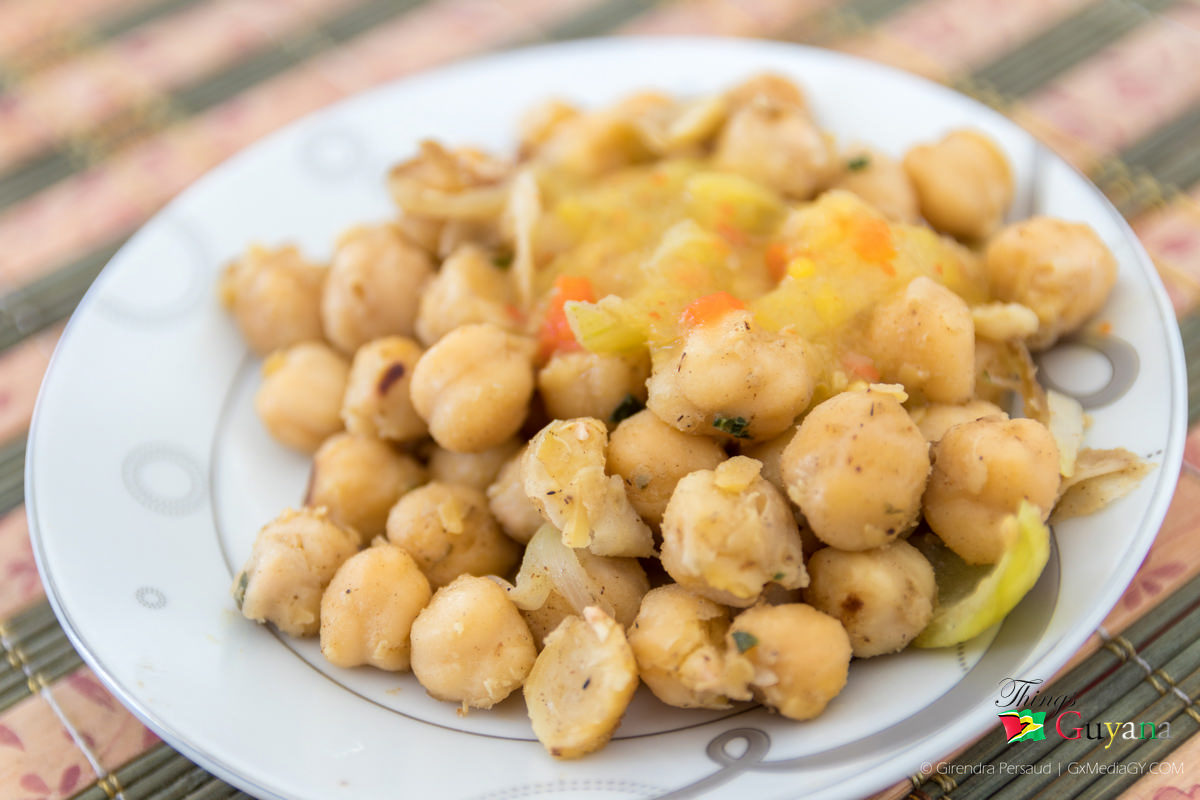Chickpeas (Cicer arietinum) are versatile legumes that’s used in many Mediterranean, Middle East and Indian cuisines. It is also known as garbanzo bean, Ceci bean, Bengal gram or Egyptian pea, and locally known as CHANNA in Guyana. These beans have been cultivated for the better part of 7,000 years, making them the oldest and most popular legumes on the planet.
Round and tan colored, channa has a mild, nutty flavor and is slightly crunchy even after cooking. Like other legumes, such as beans, peas, and lentils, channa is high in fiber and protein, and contain several key vitamins and minerals. Though the most common type of channa appears round and beige, other varieties can be black, green, and red. They are available all year and are often found in grocery stores either dried and packaged or canned.
Description Of Channa

Channa in the pods | By Eitan Ferman – Own work, Public Domain, https://commons.wikimedia.org/w/index.php?curid=2167657
The plant is quick-growing branched, and reaches a height between 20 and 60 cm, even up to 1 m. It has a deep taproot, down to 2 m, and many lateral secondary roots exploring the upper layers (15-30 cm) of the soil. The stems are hairy, simple or branched, straight or bent. Its leaves are 5 cm long with 10 to 20 sessile, ovate to elliptical leaflets. Channa flowers are white, pink to purplish or blue, typically papillonaceous and solitary. The pod is pubescent, inflated and oblong, with 2 or 3 seeds. The seeds are variable in size (5 to 10 mm in diameter), shape (spherical to angular) and colour (creamy-white to black).
Origin Of Channa
A staple of Middle Eastern, African, and Indian cuisines, channa is viewed to be among the earliest grown beans, dating as far as 5,400 BC. The very first record of consuming channa could be traced back to about 7,000 years ago. These were first grown in the Mediterranean basin around 3000 BC among Egyptians, Greeks, and Romans and were then brought to other subtropical regions by the Spanish and Portuguese explorers within the 16th century. Progressively, the Indians who’d migrated to other countries brought back channa and incorporated them within their cuisines. These days, India is definitely the biggest producer of channa, offering around 80 to 90 % of the world’s production. Other industrial producers consist of Pakistan, Turkey, Ethiopia, and Mexico.
Types of Channa

The two types of channa | Sanjay Acharya [CC BY-SA 3.0 (http://creativecommons.org/licenses/by-sa/3.0/)]
Kabuli – has got lighter colored, bigger seeds along with a softer coat, mostly grown in Southern Europe, Northern Africa, Afghanistan, Pakistan and Chile, also introduced during the 18th century towards the Indian subcontinent. These are beans are tiny, hard, knobby, beige beans about 0.95 cm round.
10 Health Benefits Of Channa
- Diabetes – Channa is particularly high in fiber. Studies have shown that people with type 1 diabetes who consume high-fiber diets have lower blood glucose levels. For people with type 2 diabetes, higher fiber intake may improve blood sugar, lipid, and insulin levels. The Dietary Guidelines for Americans recommends a minimum of 21 to 25 grams (g) of fiber per day for women and 30 to 38 g per day for men.
- Bone health – The iron, phosphate, calcium, magnesium, manganese, zinc, and vitamin K in chickpeas all contribute to building and maintaining bone structure and strength. Though phosphate and calcium are both important in bone structure, the careful balance of the two minerals is necessary for proper bone mineralization – consumption of too much phosphorus with too little calcium intake can result in bone loss. Bone matrix formation requires the mineral manganese, and iron and zinc play crucial roles in the production and maturation of collagen. Adequate vitamin K consumption is important for good bone health because it improves calcium absorption and may reduce urinary excretion of calcium, making sure that enough calcium is available for building and repairing bone. Low intake of vitamin K is associated with a higher risk for bone fracture.
- Blood pressure – Maintaining a low-sodium (low-salt) intake is essential for maintaining a low blood pressure, however increasing potassium intake may be just as important because of its vasodilation effects. According to the National Health and Nutrition Examination Survey, fewer than 2 percent of United States adults meet the daily 4,700-milligram recommendation.
- Heart health – The high fiber, potassium, vitamin C, and vitamin B-6 content all support heart health. Channa contain significant amounts of fiber, which helps lower the total amount of cholesterol in the blood, thereby decreasing the risk of heart disease. In one study, those who consumed 4,069 milligrams of potassium per day had a 49 percent lower risk of death from ischemic heart disease compared with those who consumed less potassium (about 1,000 mg per day).
- Cancer – Although the mineral selenium is not present in most fruits and vegetables, it can be found in channa. It helps the enzymes of the liver to function properly and detoxify some cancer-causing compounds in the body. Additionally, selenium prevents inflammation and decreases tumor growth rates. Channa also contain folate, which plays a role in DNA synthesis and repair, and so helps prevent the formation of cancer cells from mutations in the DNA. Saponins, phytochemicals present in channa, prevent cancer cells from multiplying and spreading throughout the body. High-fiber intakes from channa and other legumes, whole grains, fruits, and vegetables are associated with a lowered risk of colorectal cancer. Vitamin C functions as a powerful antioxidant and helps protect cells against free radical damage.
- Cholesterol – Research shows that including channa in the diet lowers the amount of low-density lipoprotein, or bad cholesterol, in the blood.
- Inflammation – The choline in channa helps with sleep, muscle movement, learning, and memory. Choline also helps to maintain the structure of cellular membranes, aids in the transmission of nerve impulses, assists in the absorption of fat and reduces chronic inflammation.
- Digestion and regularity – Because of their high fiber content, channa helps to prevent constipation and promote regularity for a healthful digestive tract.
- Weight management and satiety – Dietary fibers function as “bulking agents” in the digestive system. These compounds increase satiety (a feeling of fullness) and reduce appetite, making people feel fuller for longer and thereby lowering overall calorie intake. Consuming fruits and vegetables of all kinds has long been associated with a reduced risk of many lifestyle-related health conditions. Many studies have suggested that increasing consumption of plant foods like channa decreases the risk of obesity, overall mortality, diabetes, heart disease, promotes a healthful complexion, healthful hair, increased energy, and overall lower weight.
- Irritable bowel syndrome – Although channa do not ease the symptoms of irritable bowel syndrome, they can be helpful to people affected by the condition. Patsy Catsos, a registered dietitian and author of “IBS – Free at Last!” suggests that increasing fiber consumption in individuals who have irritable bowel syndrome (IBS) can be a challenge. However, channa offer a source of fiber that is well-tolerated by some IBS patients.
Other Use
- For dandruff, make a paste with chickpea flour and some water. Massage this on your scalp and leave it for half an hour before washing off.
- Chickpea flour is also good for oily, spotty skin. Simply combine some flour with milk and rose water to make a face mask.
Side Effects
While the majority of channa benefits are wonderful, there can be certain side effects:
- They possess purines, which can be broken down by the body into uric acid and cause various health conditions including kidney stones, gallstones, and gout. So avoid intake if you suffer from any of these conditions.
- The high fiber and starch content of the beans could cause digestive discomfort in some. The best solution, in this case, is to gradually start to include it in your diet.
Traditional Uses Of Channa
- An acid exudation from the seedpods is astringent.
- Channa acid exudates have been used to treat bronchitis, catarrh, cholera, constipation, diarrhea, dyspepsia, flatulence, snakebite, sunstroke and warts.
- They have also been used as an aphrodisiac and to lower blood cholesterol levels.
- Germinated chickpea has been reported to be effective in controlling cholesterol level in rats.
- In Chile, a cooked channa-milk mixture has been fed to infants, effectively controlling diarrhea.
- Channa seeds are considered to be anti-bilious (to combat nausea, abdominal discomfort, headache, constipation and gas caused by an excessive secretion of bile.
Culinary Uses Of Channa
- The fresh or dried seed is cooked in soups, stews etc.
- Parched seeds can be eaten as a snack.
- The seed can also be ground into a meal and used with cereal flours for making bread, cakes etc.
- The roasted seed is a coffee substitute.
- A refreshing drink can be made from the acid dew that collects on the hairy seedpods overnight.
- In India, channa is used to make dhal.
- The seed flour may be used to make confections.
- In the Mediterranean region, channa is used to make hummus.
- Channa flour is known as gram flour or besan in South Asia and used frequently in South Asian cuisine.
- In Italy, channa is eaten with pasta or in soup.
- In southern Italy, chana flour is made into a batter for panelle, a sort of crepe.
- In Egypt, channa is used as a topping for kushari.
- Some varieties of channa can be popped and eaten like popcorn.
- In the Philippines, channa preserved in syrup are eaten as sweets and in desserts such as halo-halo.
- In some parts of the world, young channa leaves are consumed as cooked green vegetables.
- Channa may also be roasted, salted and consumed as snacks.
Here is how to make boil and fry channa (Guyanese style)

Boiled and Fried Channa with Mango Sour
Ingredients:
- 2 cups chick peas (raw has to be soaked overnight)
- 4 stems scallions
- 1 tbsp roasted ground cumin (geera)
- 1 onion
- 12 cloves garlic
- pepper (optional)
Method:
Boiling and preparing the seasonings
- Wash chick peas and pressure or boil with salt to taste until it is a bit soft (about 15 mins of pressuring).
- While that is boiling chop scallions and onions, set aside.
- In a mortar grind garlic and pepper (if you are using pepper).
- When chick peas is done strain and leave ti drain.
Frying
- Set your stove to medium
- Add some oil to a pan and heat
- Add the scallions and onion and fry for about 30 secs.
- Add ground garlic and pepper, fry for another 30 sec to 1 min.
- Add the chick peas and mix well.
- Taste for and adjust salt.
- Add cumin and mix in well.
- Remove from stove
- All done, enjoy!
About Channa
Channa are versatile legumes that’s used in many Mediterranean, Middle East and Indian cuisines. In Guyana, it is prepared in many ways eg, boil and fry, channa curry, and fried to eat as a quick snack. It is packed with many health benefits and many traditional uses.







